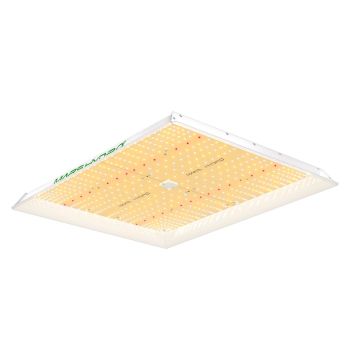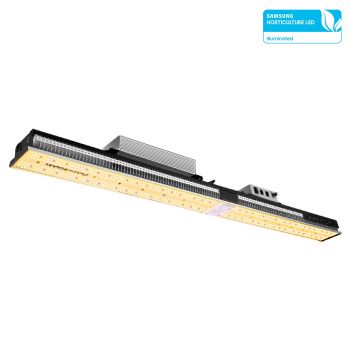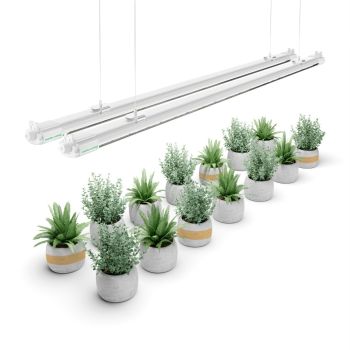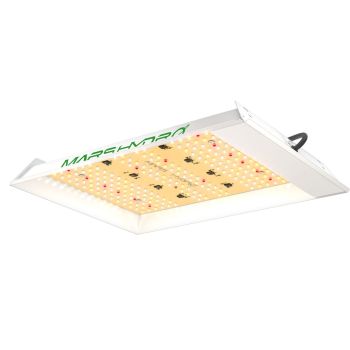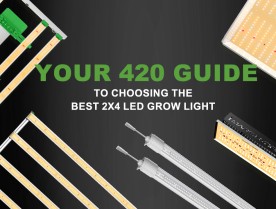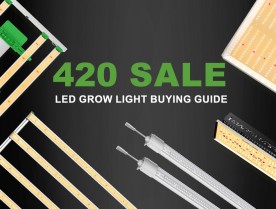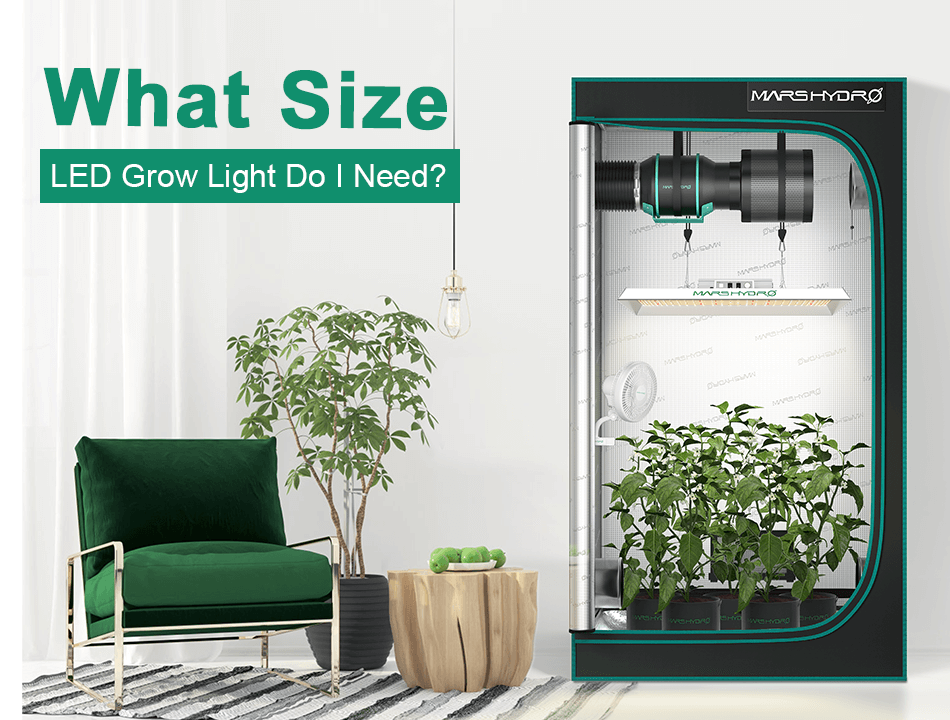
Growing plants indoors can be a great way to bring some greenery into your living space or even cultivate your own fresh herbs and vegetables. However, indoor plants require a different type of lighting than outdoor plants and choosing the right LED grow light size is the first step to making all the difference in the growth and health of your plants. With so many options on the market, it can be overwhelming to know where to start.
In this guide, we'll walk you through everything you need to know to pick the perfect LED grow light size for your indoor garden, including factors to consider, how to calculate the right size, and tips for maximizing your plants' growth potential. Whether you're a seasoned indoor gardener or just getting started, you'll come away with the knowledge you need to keep your plants thriving year-round.
Narrowing Down Your Options in 3 Steps
The vast array of grow light options in today's market can make it a daunting task to identify the appropriate lighting system for your indoor garden. Nonetheless, reducing your options can significantly facilitate the selection process.
Plant Species and Their Lighting Requirements
The type of plant being cultivated and its lighting needs are critical factors when it comes to appropriate LED grow light size. Different plant species require varying amounts of light to grow optimally. Plants that originate from sunny climate require much more intense light than plants such as leafy greens and herbs.
What are DLI and varying DLI for Plants
DLI, or Daily Light Integral, is a measurement of the total amount of light that a plant receives over the course of a day. It's commonly used to ensure that their plants receive the right amount of light to avoid under or overexposure. Here we list DLI for common plants.
-
DLI for Medical Weed: 40-60 mol/m²/d
-
DLI for Peppers: 30-45 mol/m²/d
-
DLI for Tomatoes: 25-45 mol/m²/d
-
DLI for Succulents: 30-50 mol/m²/d
-
DLI for Basil: 18-29 mol/m²/d
-
DLI for Thyme: 12-15 mol/m²/d
-
DLI for Mint: 10-16 mol/m²/d
-
DLI for Sage: 11-15 mol/m²/d
-
DLI for Cilantro: 12-15 mol/m²/d
-
DLI for Lettuce: 10-17 mol/m²/d
-
DLI for Spinach: 14-18 mol/m²/d
-
DLI for Kale: 15-25 mol/m²/d
-
DLI for Petunias: 12-16 mol/m²/d
-
DLI for Cucumber: 20-35 mol/m²/d
-
DLI for Pansies: 12-18 mol/m²/d

How to calculate DLI from the PPFD metrics provided
LED grow light vendors always provide the PPFD metrics in their LED specifications as proof of their fixture performance. We can do some easy calculations and know if this fixture meets the lighting requirements by the measurement of DLI.
To calculate DLI from the PPFD (Photosynthetic Photon Flux Density) metrics provided, you need to know the amount of PPFD emitted by your light source (vendor provides), and the length of time (everyday lighting hours) your plants are exposed to this light.
There's a simple formula, where the content in brackets is what you need to fill in:
-
[PPFD] x [Everyday Lighting Hours] x 3600 seconds ÷ 1,000,000 = DLI mol/m²/day
So, to calculate how much PPFD you need from the light fixture, use the below formula:
-
[DLI] x 1,000,000 ÷ 3600 ÷ [Everyday Lighting Hours] = [PPFD]
E.G.: [50 mol/m²/day] x 1,000,000 ÷ 3600 s ÷ [18 h] = 771.6 μmol/m²/s
Therefore, if your plants require a DLI of 50 mol/m² per day, and your lighting schedule for it is 18 hours, then you need a light fixture that produces at least 771.6 μmol/m²/s PPFD.

Establish Whether Your Grow is for Seedling, Veg, Flowering, or Full Cycle Growing
The DLI above provides a general range of required lighting, however, the growth stage of the plant will also affect the required PPFD (or DLI). Even if you grow the same planned varieties, their lighting needs will vary depending on their growth stage. Too much light or too little light is not good for your plants. For healthy growth of your indoor plants, PPFD (or DLI) must be specified for each growth stage of the plant. Since many manufacturers always display the PPFD figures, it would be more convenient if using PPFD.
Mars Hydro has published a complete guide on what the PPFD is for common plants at different growth stages. Therefore, we will only give a brief list here rather than a detailed introduction.
-
Weed Plants: Seedling stage - 100~300 μmol/m²/s , Vegetative stage - 400~600 μmol/m²/s , Flowering stage - 800~1,000 μmol/m²/s.
-
Cucumbers and Tomatoes: Seedling stage - 100~200 μmol/m²/s, Vegetative stage - 200~500 μmol/m²/s, Flowering/Fruiting stage - 500~600 μmol/m²/s.
-
Pepper Plants and other Flowering Plants: Seedling stage - 100~300 μmol/m²/s, Vegetative stage - 300~600 μmol/m²/s, Flowering stage - 600~750 μmol/m²/s.
-
Lettuce and Herb: Seedling stage - 100 μmol/m²/s, Vegetative/Mature stage - 100~250 μmol/m²/s.

Growing Area Size and Shape Matter
When selecting the right LED grow light size, it's important to consider the size and shape of the growing area. The size of the grow area will determine the number of LED lights required, and the shape will determine the distribution of light coverage.
A larger grow area will require more LED lights to ensure adequate light penetration and uniformity. The shape of the grow area will also impact the distribution of light coverage, as some LED lights may provide a more concentrated beam angle, while others may have a wider spread.
However, if you use a grow tent, the grow tent size matters the most. It's of course the best condition when the led grow light coverage matches exactly the grow tent size. But if you're growing plants that are in need of less light, it is recommended to use a grow light thatcovers at least 75% of the tent's surface area to ensure optimal growth for plants and optimal cost for your wallet.
Additionally, the height of the plants in the grow area should be taken into account, as taller plants may require more intense light and a higher wattage LED grow light to ensure proper growth and development.
Ultimately, selecting the right LED grow light size will require careful consideration of the size and shape of the grow area, as well as the specific needs of the plants being grown.
What Size LED Grow Light Do I Need?
After completing the 3 steps above, you've confirmed the basic information you need about the LED light fixture: the PPFD it should produce, the shape it should cover, and the size of the area it covers.
How Many Watts Per Square Foot For LED Grow Lights?
Using wattage to calculate the size of your led grow lights was considered a good way to calculate the size of your led grow lights. You may have read about it in other articles, so let's take a quick look.
Generally, a range of25-50 watts per square foot is considered adequate for most plants in the vegetative stage, while flowering plants may require a higher wattage of40-60 watts per square foot.
However, some high-light plants, such as tomatoes and peppers, may require even higher wattage levels. It's important to note that the efficiency and quality of the LED grow light can also impact the recommended wattage per square foot, as some high-quality LED lights may require less wattage to achieve the same level of light output as lower-quality lights. Additionally, the hanging height between the LED light and the plants will also impact the intensity of the light and the recommended wattage per square foot.
Overall, determining the optimal wattage per square foot for LED grow lights will require careful consideration of the specific needs of the plants being grown and the quality and efficiency of the LED grow light being used.
HPS to LED Equivalency
HPS (High-Pressure Sodium) grow lights have been a popular choice for indoor plant cultivation for many years. However, with advancements in LED (Light Emitting Diode) technology, more and more growers are making the switch to LED grow lights.
As a general rule, a high-quality LED grow light will produce the same amount of light as an HPS grow lighting with approximately30-50% less wattage. For example, if you are currently using a 1000-watt HPS light, you may only need a 500-700 watt LED light to achieve the same level of lamp output.
How Much PPFD Per Square Foot For LED Grow Lights?
PPFD is easier to understand because it expresses the relationship between area and value explicitly in the unit of measure. PPFD is typically measured in units of micromoles per square meter per second (μmol/m²/s). That is to say, if you want to know how much PPFD per square foot you need, just do a conversion between square meters and square feet.
-
1 square foot = 0.0929 square meter
-
PPFD (µmol/m²/s) x 0.0929 = PPFD (µmol/ft²/s)
E.G. : 600 μmol/m²/s x 0.0929 = 55.74 µmol/ft²/s
So, for example, a weed plant in the vegetative stage would require approximately 37.2-55.8 µmol/ft²/s (400-600 µmol/m²/s x 0.0929), and a weed plant in the flowering would require approximately 74.3-92.9 µmol/ft²/s (800-1000 µmol/m²/s x 0.0929). However, this way is not common to see and use to find out the size of your lamp. The PPFD(µmol/m²/s), considered in other articles as usable PPF, is the more common measurement.
Other Considerations When Choosing LED Grow Lights
While you've learned various ways to pick the right size led grow light, there are other considerations that can impact the overall success of your indoor garden due to the led grow light you choose.
Analyze PAR Maps and Light Uniformity
A PAR map, or a PPFD chart, is a visual representation of the intensity and distribution of PAR within a specific area, usually presented by the vendors in the light coverage. It provides valuable information about how much light at every inch that plants receive, allowing growers to easily understand the light performance and decide whether this LED grow light meets their lighting systems for maximum plant growth.
Light uniformity, on the other hand, refers to the evenness of light distribution within a given space, which can be clearly identified through a PAR map. Uneven light distribution can result in some areas receiving more light than others, leading to uneven plant growth and yield. By measuring and analyzing light uniformity, growers can identify areas that require more or less light and adjust their lighting systems accordingly.

Here are some tips for interpreting a PAR map to gain insight into light uniformity:
-
Look for hot spots: Hot spots are areas where the light intensity is particularly high. These can indicate areas where light uniformity is poor, as plants in these areas may be receiving more light than they need. Plants will likely grow towards the hot spot and be more robust under the hot spot, or, in the contrast, their leaves will be burnt by the hot spot.
-
Look for cool spots: Cool spots are areas where the light intensity is particularly low. These can indicate areas where light uniformity is poor, as plants in these areas may not be receiving enough light. The cool spots indicate the surrounding light distribution that affects whether the side and the deep branches can absorb enough light. If gardeners do not grow in grow tents or within a reflective area that allows for light reflection to enhance side light, the cool spots may lead to weak growth.
-
Look for patterns: Patterns, which are usually seen in a PAR meter when using multiple led grow lights, in the PAR map can provide insight into the cause of uneven light distribution. For example, if the PAR map shows a pattern of stripes, this could indicate that the light fixtures are spaced too far apart. By identifying patterns, you can adjust your lighting system to provide more even light distribution.
Overall, learning light uniformity through a PAR map involves careful analysis of the intensity and distribution of PAR within a space, and using this information to optimize your lighting system for optimal plant growth and development.
Dimming and Dasiy Chain Controls
When investing in grow lights for indoor horticulture, it's important to consider the functionality of the product.
LED Grow lights are designed to provide plants with the necessary light to thrive, but different plants have different answers to how much light at the seedling, vegetative, and flowering stages of their growth. This is where dimming controls come into play. By being able to adjust the intensity of the grow lights, you can create a customized lighting environment for your plants.
Additionally, daisy chain controls allow for the seamless connection of multiple grow lights, simplifying the setup process and eliminating the need for numerous dimming operations. Growers can control all the lights' intensity by turning only one knob.

It is important to ensure that the grow lights you choose come with both dimming and daisy chain controls to maximize the effectiveness and efficiency of your indoor gardening operation. By doing so, you can create an optimal lighting environment for your plants and promote healthy growth, while also simplifying the setup and operation process.
Additional Features and Customization Option On LED Grow Light
As the popularity of indoor gardening continues to grow, so does the demand for smart features and customization options in LED grow lights.
Smart features such as remote control access and scheduling capabilities allow growers to easily manage their grow lights from a distance and optimize their LED lighting schedules for optimal plant growth.

Additionally, customization options such as spectrum control and adjustable brightness provide growers with more control over the light output, allowing them to fine-tune their lighting environment to meet the unique needs of their plants.
These features and options not only simplify the management of indoor gardens but also provide an enhanced growing experience by promoting healthy plant growth and reducing energy consumption. As a result, it's important to consider the availability of smart features and customization options when investing in LED grow lights, as they can greatly enhance the effectiveness and efficiency of your indoor gardening operation.
Recap of Key Points
In this article, we learn how to pick the perfect LED grow light size for indoor gardening. First, we narrow down the grow light options by considering the plant species and their lighting requirements. The DLI, which measures the total amount of light that a plant receives over a day, is crucial in determining the right LED grow light size. PPFD can be used to calculate DLI from the metrics provided in LED specifications. By establishing whether the grow is for seedling, veg, flowering, or full-cycle growing, we can determine the required PPFD (or DLI) for each growth stage of the plant. A brief list of PPFD for common plants at different growth stages is also provided.
Mars Hydro hereby welcomes worldwide indoor growers who are seeking the best led grow lights to take a look at our LED Grow Light Collection. There should be one that will meet your gardening needs.


